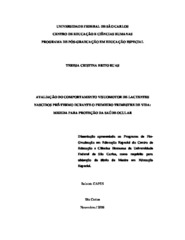Avaliação do comportamento visuomotor de lactentes nascidos pré-termo durante o primeiro trimestre de vida: medida para proteção da saúde ocular
Abstract
The primary function of vision is related to achievements in infant development. The
visual behavior is known to be acquired once visual stimuli are processed by retinal
cells and then transmitted to the cerebral cortex by neurovisual pathways. This
neuromaturational process progresses as visual stimuli are received by the neurons and
synapses are moved from one nerve cell to another, thus promoting a normal visual
development. The prematurity of the infant has been described to be an important
indicator of risk for morbidity during the visuomotor development. Infants likely to
have visuomotor impairment during this period should thus be provided with special
follow-up. In this regard, this longitudinal study aims to assess the visuomotor behavior
in infants at risk for disorders during the first three months of life. The infants were
recruited from the Program for Detecting Audiological Disorders in Newborns
(DAANE), in the Center of Studies and Research on Rehabilitation Prof. Dr. Gabriel
Porto at the School of Medical Sciences of the University Estadual of Campinas
(CEPRE/FCM/UNICAMP). The participants were evenly divided into two groups of 21
infants. The experimental group was composed of preterm infants with gestational age
under 37 full weeks, and a correected age of 1 to 3 months. The control group consisted
of fullterm infants with gestational age ranging from 37 full weeks to 41 weeks and 6
days, and a chronological age of 1 to 3 months. Each infant was assessed three times at
regular intervals through the Method for the Assessment of Infant Visual Behavior. The
data was stored in a file form for the data bank of the program Statistical Package for
Social Sciences for Personal Computer (Versão 14). The Cochran s Q-test was applied
to compare the three months (assessment) in each group, and the Yates test was used to
compare the two groups in each month. The results indicated that although linearity and
sequence in visuomotor achievements were similar between the two groups, the rhythm
and pattern of visuomotor development were different between them. In the first two
months of life, fullterm infants were shown to acquire the great majority of the
oculomotor and apendicular functions in a more rapid and frequent way. These results
point to the importance of correcting gestational age when assessing the visuomotor
behavior of infants at risk. This study provides a material for informational and
instrumental support for parents regarding the normal visual development of infants
from birth to the sixth month of life. Furthermore, this study contributes towards a
further understanding of the visuomotor development of preterm infants, and promotes
an opportune detection of possible signs indicative of visuomotor impairment so that the
infant can receive a timely diagnosis.
